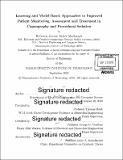Learning and model-based approaches to improved patient monitoring, assessment and treatment in capnography and procedural sedation
Author(s)
Mieloszyk, Rebecca Jennie Asher
DownloadFull printable version (14.67Mb)
Other Contributors
Massachusetts Institute of Technology. Department of Electrical Engineering and Computer Science.
Advisor
Thomas Heldt and George C. Verghese.
Terms of use
Metadata
Show full item recordAbstract
Disease assessment, diagnosis, and treatment are facilitated by appropriate patient monitoring. In this work, we bring quantitative and model-based methods to two settings in which current monitoring modalities are largely qualitative, and evaluate them on extensive clinical data collected by our collaborators. The first setting is time-based capnography, where our quantitative approach allows improved diagnosis of important cardiorespiratory conditions. The second setting is procedural sedation, where our model-based approach to assessing patient state can provide valuable guidance and improve efficiency and safety for titration of sedative agents. Capnography describes the measurement of the partial pressure of carbon dioxide in exhaled air through a non-invasive and effort-independent process, with the resulting waveform, termed the capnogram, reflecting changes in the physiological functions of ventilation, perfusion, and metabolism. We quantitatively analyzed the capnogram shape to aid in diagnosis or screening for respiratory disease. The analysis involves preprocessing, extraction of physiologically based features, and development of ensemble-based classifiers based on quadratic discriminant analysis. We applied these methods to capnograms from 30 normal controls and from 109 patients admitted to the emergency department with a chief complaint of respiratory distress and a discharge diagnosis of either congestive heart failure (CHF) or chronic obstructive pulmonary disease (COPD). The performance on the classification tasks associated with CHF vs. COPD diagnosis and COPD vs. normal screening is characterized by areas under the receiver operating characteristic (ROC) curve of 0.89 (95% CI: 0.72-0.96) for the diagnostic task and 0.98 (95% CI: 0.82-1.0) for the screening task. We obtained comparable accuracy for CHF vs. COPD diagnosis with capnograms recorded on 18 patients being transported by ambulance. Application of our COPD vs. normal screening tools to capnograms of 25 asthmatic patients undergoing a methacholine challenge showed approximately a third fewer exhalations classified as normal when challenged with methacholine, and approximately a third more exhalations classified as normal when treated with bronchodilators after the challenge. Procedural sedation refers to the use of medications to alleviate patient pain and anxiety during medical procedures performed outside the operating room. We demonstrate that online clustering of features extracted from the capnograms of 30 patients undergoing procedural sedation for cardioversion procedures identifies separable clusters, or states, whose transition times are aligned with those of relevant clinical events. Through pharmacokinetic modeling, we continuously compute the estimated sedation agent plasma concentration of patients over the course of procedural sedation. In the analysis of 38 patients sedated with propofol and with regularly annotated Ramsay sedation scores, the performance of a threshold test on the estimated plasma concentration to predict a sedation score of 4 or greater is characterized by area under the ROC of 0.97 (95% CI: 0.967-0.971). Defining a titration threshold as the mean of estimated end-procedure plasma concentrations with and without the final bolus of sedation agent, we calculate titration thresholds of 1.7 [mu]g/ml and 3.7 [mu]g/ml for propofol sedation in two distinct patient groups of sizes 23 and 35 respectively, and 0.51 [mu]g/ml for both the propofol and ketamine components for 1:1 ketofol sedation in a third group of 32 patients. The outputs of feature-based capnogram analysis and pharmacokinetic modeling of drug plasma concentration can thus provide continuous patient assessment and allow for more quantitatively defined drug titration during procedural sedation.
Description
Thesis: Ph. D., Massachusetts Institute of Technology, Department of Electrical Engineering and Computer Science, 2016. Cataloged from PDF version of thesis. Includes bibliographical references (pages 115-129).
Date issued
2016Department
Massachusetts Institute of Technology. Department of Electrical Engineering and Computer SciencePublisher
Massachusetts Institute of Technology
Keywords
Electrical Engineering and Computer Science.